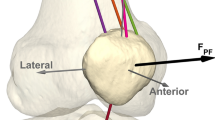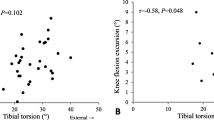Summary
The influence of mediolateral deformity, tibial torsion, and different centers of foot support was studied with a three-dimensional computer model that incorporates the significant muscles of the lower extremities needed for quasi-static walking. This theoretical method avoids the variability in gait pattern from the pain and discomfort associated with deformity in patients. The study illustrates the possible importance of the muscle force on the load across the knee and ankle. High strains in the medial gastrocnemius and the medial hamstring created particularly high loads in the medial compartment of the knee. Internal torsion and varus deformity were associated with the highest loads in the medial compartment of the knee, although the peak load for each deformity occurred in different phases of the gait cycle. Both external torsion and valgus deformity generally decreased the load in the medial compartment, but early in the gait cycle external torsion increased the loads on the medial side. In addition, when the center of support of the body was in the forefoot, the loads through the knee were lower than when foot support was at the heel. As expected, if the center of support was on the lateral foot line, the lateral compartment was subjected to more load and, conversely, when the center of support was on the medial part of the foot the medial compartment of the knee was more loaded. Although the predicted forces agree well with those found with other methods, we think that the model is best used to measure the direction of influence of specific factors.
Similar content being viewed by others
References
Andriacchi TR, Schipplien OO, Galante JO (1985) Dynamic analysis of medial compartmental loading in assessment of high tibial osteotomy. Proc Orthop Res Soc, p 281
Arvikar RJ, Seireg A (1973) Muscular control of human posture and locomotion. Regulation and control in physiological system. Instrument Society of America, Pittsburgh, p 236
Arvikar RJ, Seireg A (1975) A three-dimensional model for analysis of the human jaw during mastication. 28th Annual Conference of Engineering in Medicine & Biology (ACEMB). Published by The International Federation for Medical and Biological Engineering
Arvikar RJ, Seireg A (1977) A musculoskeletal analysis of the pinch action. 30th ACEMB (see [3])
Arvikar RJ, Seireg A (1978) Evaluation of upper extremity joint forces during exercise. Adv Bioeng ASME (American Society of Medical Engineers, NY)
Arvikar RJ, Seireg A (1980) A pressure distribution under the foot during static activities. Eng Med 9:2
Arvikar RJ, Seireg A, Murray MP (1980) Interactive computing as a diagnostic tool for musculoskeletal disabilities. Adv Comp Tech ASME (see [5])
Harrington JJ (1983) Static and dynamic loading patterns in knee joint with deformities. J Bone Joint Surg [Am] 65: 247–258
Hernborg JS, Nilsson BE (1977) The natural course of untreated osteoarthritis of the knee. Clin Orthop 123:130–137
Johnson F, Leitl S, Waugh W (1979) The distribution of load across the knee. J Bone Joint Surg [Br] 62:346–349
Maquet PGJ (1976) Biomechanics of the knee. With application to the pathogenesis and the surgical treatment of osteoarthritis. Springer, Berlin Heidelberg New York
Miller N, Seireg A (1975) Experimental procedure for investigating the effects of load and speed on muscle electromyographic activity during bicycling. 28th ACEMB (see [3])
Morrison JB (1968) Bioengineering analysis of force actions transmitted by the knee joint. Biomed Eng 3:164–170
Seireg A, Arvikar RJ (1973) A mathematical model for evaluation of forces in lower extremities of the musculoskeletal system. J Biomech 313–326
Seireg A, Arvikar RJ (1975) The prediction of muscular load-sharing and joint forces in the lower extremities during walking. J Biomech 89–102
Seireg A, Arvikar RJ (1975) A comprehensive musculoskeletal model for the human vertebral column. Adv Bioeng ASME (see [5])
Williams R, Seireg A (1977) Interactive computer modelling of the musculoskeletal system. TEE Trans, J Biomed Eng 24:213
Williams R, Seireg A (1979) Interactive modeling and analysis of open- or closed-loop dynamic systems with redundant actuators. ASME Trans, J Mech Design
Author information
Authors and Affiliations
Rights and permissions
About this article
Cite this article
Lindgren, U., Seireg, A. The influence of mediolateral deformity, tibial torsion, and foot position on femorotibial load. Arch Orthop Trauma Surg 108, 22–26 (1989). https://doi.org/10.1007/BF00934152
Received:
Issue Date:
DOI: https://doi.org/10.1007/BF00934152




